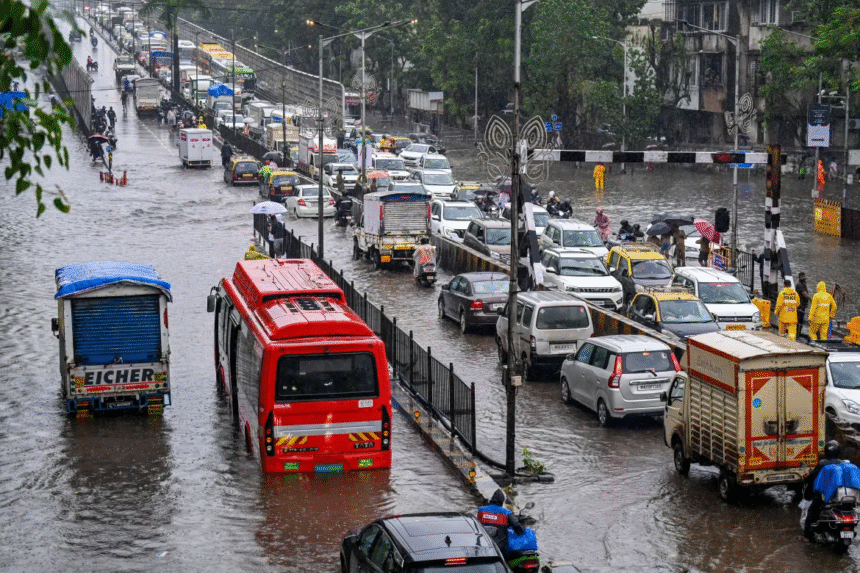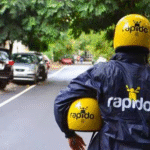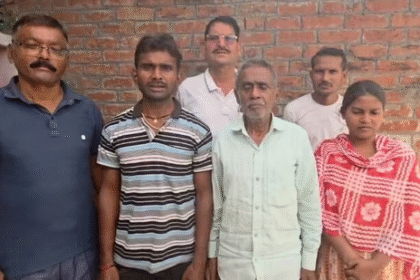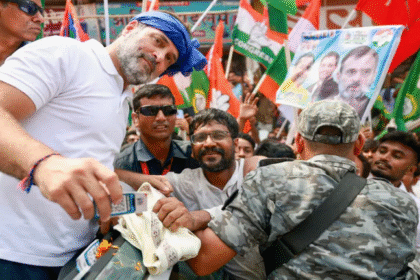IMD Predicts 100mm+ Rainfall – Severe Waterlogging, Traffic Chaos, Train Delays Expected
Mumbai is set to witness heavy rainfall and overcast skies from 5 to 7 July, with the IMD issuing a yellow alert. Residents have been advised to brace for waterlogging, traffic delays, and high humidity
As Mumbai dives deeper into the monsoon season, the city is gearing up for another spell of heavy showers and waterlogged streets. The India Meteorological Department (IMD) has issued a yellow alert, forecasting persistent rainfall, overcast skies, and a highly humid atmosphere from 5 to 7 July. For Mumbaikars, it’s time to keep those umbrellas close and prepare for a drenched weekend.
The IMD has predicted generally cloudy skies with heavy rainfall across the city, with intense spells expected especially in the afternoon and evening hours. July 5 is set to begin on a cloudy note, gradually building into heavier showers later in the day. The forecast holds a yellow alert for heavy rainfall through 6 and 7 July as well.
Wind speeds are likely to hover between 20 to 30 km/h, bringing a bit of relief from the still, muggy air — though not enough to offset the high levels of humidity. With relative humidity expected to stay between 80% and 95%, temperatures of 29°C to 31°C will likely feel warmer and more uncomfortable than they appear.
The IMD has issued advisories warning of sudden and intense downpours, particularly in low-lying pockets of the city that are known to flood quickly. Commuters are being urged to plan travel carefully and expect possible delays in public transport and heavier traffic on key roads. Civic authorities have reiterated the importance of caution, especially during peak hours.
The Brihanmumbai Municipal Corporation (BMC) has activated its monsoon contingency plans, including operations at stormwater pumping stations and 24/7 control rooms. Officials stated that pre-monsoon desilting operations conducted in May have marginally improved drainage, but Mumbaikars are all too familiar with how just an hour of heavy rain can grind traffic to a halt.
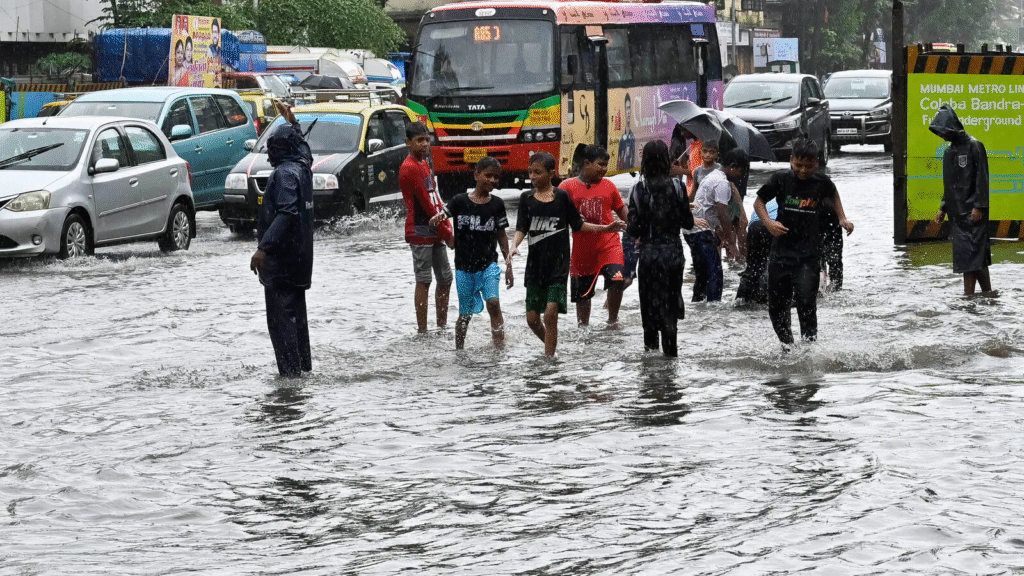
The IMD has also cautioned fisherfolk against venturing into the sea, citing unstable marine conditions and the potential for rough waves. Coastal residents and those living in flood-prone areas have been advised to monitor alerts and avoid unnecessary travel during the rain-heavy hours of the day.
While the monsoon is vital for replenishing water levels and cooling down the post-summer heat, it also exposes long-standing gaps in the city’s urban planning and drainage infrastructure. Experts have warned that with climate patterns shifting, extreme weather events like these are becoming the norm rather than the exception.
Environmental planners believe the rains offer a chance to reimagine the city’s layout — through smarter rainwater harvesting, sustainable drainage systems, green corridors, and weather-responsive infrastructure.
The monsoon is expected to remain active over the Konkan coast throughout the weekend, with uneven rainfall across different micro-zones in the city. The pattern of afternoon to evening showers is likely to continue until early next week. There are currently no red alerts for extreme rainfall, but residents are advised to stay tuned to updates from IMD and BMC for any sudden changes.
Mumbai is bracing for a severe monsoon onslaught, with the India Meteorological Department (IMD) forecasting 100 mm+ rainfall, triggering alerts for waterlogging, traffic paralysis, and delays across road, rail, and air networks. Here’s an in-depth, 500+ word breakdown of what Mumbaikars can expect—and how to stay safe and prepared.

IMD has issued alerts due to 100+ mm of rainfall falling over short periods—conditions that qualify as very heavy to extremely heavy rain .
Gusty winds of 50–60 km/h are expected alongside thunderstorms and lightning
The BMC has reported significant waterlogging in low-lying areas including Nariman Point (104 mm), A Ward (86 mm), Colaba (83 mm), and the Municipal HQ (80 mm)
These deluges are overwhelming drains and low-lying pockets, leading to flooded drains and traffic standstills in spots like Andheri, Malad subways, Bandra, Dadar, Parel, Kalachowki
Vehicular traffic across Mumbai is expected to crawl or halt in waterlogged areas. Major choke-points include BKC, CST Junction, Sion Bridge, and the Andheri/Malad subways
Instances of tree falls and short-circuits have already been reported, causing local power outages and road obstructions
High tides (4–5 metres) coincide with downpours, exacerbating flooding in coastal and river-adjacent zones like Mithi River basin
Central Line locals, including routes through Masjid, Byculla, Dadar, Matunga, and Badlapur, are running at reduced speeds due to waterlogged tracks and low visibility
The Western Railway fares marginally better but may face tailback delays .
On the Mumbai Metro (Line 3), water seepage has forced a suspension of services at Acharya Atre Chowk
Airlines such as Air India, IndiGo, and Akasa are advising early arrival at the airport—250+ flights have already been canceled or diverted, with some runways temporarily shut
Rain-induced runway closures have delayed movements, and air traffic control is cautioning additional disruptions.
Currently, no casualties have been reported—though there were 25+ short-circuits, 10 partial building collapses, and fallen trees .
The BMC has mobilized 6,000+ field workers and 417 high-capacity pumps to ease flooding
Public advisories against unnecessary travel have been broadcast via SMS to 95 million Maharashtra residents
Travel Smart
- Opt for suburban trains over road travel during peak rain.
- Expect delays: 1–3 hours on roads, 5–15 minutes on trains, and hours of flight disruptions.
Stay Informed
- Monitor IMD bulletins, BMC helpline 1116, and airline updates before heading out.
Dress for the Deluge
- Carry raincoats, sturdy waterproof shoes, and plan for soggy commutes.
Prepare for Power & Communication Issues
- Keep flashlights, portable chargers, and essential medicines handy in case of power outages.
Mind High Tide Windows
- The 11 am and 11 pm high tides increase flood risk—avoid low‑lying coastal zones during these peaks.
This forecast marks some of the heaviest rainfall spells of the season, making it essential for residents to exercise extreme caution. With 100+ mm downpours, city infrastructure is being severely tested, but proactive measures from IMD, BMC, railways, metro, and airlines aim to mitigate impact.
Understanding the numbers behind the storm puts Mumbai’s resilience into perspective:
- 100 mm+ rainfall → extremely heavy downpour; drenching.
- 60 km/h winds → toppled trees and utility hazards.
- 250+ flights canceled/diverted → air travel chaos.
- 6,000+ responders + 417 pumps → aggressive civic intervention.
Read Also : Vijay Mallya, Lalit Modi Sing at ₹100 Crore UK Party in 2025


